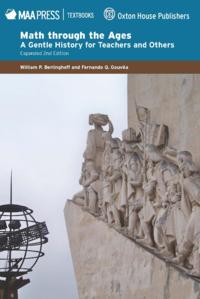

|
Fernando Q. GouvêaCarter Professor of Mathematics
|
I work in the Department of Mathematics at Colby College. The links will take you to the department home page and the Colby home page. There’s also an official professional profile page.
In the Fall of 2024 I am teaching Abstract Algebra (MA333) and Probability (MA381).
My office hours this semester are Mondays and Wednesdays from 1:00 to 3:30 PM.
If you need to see me at a different time, please email me to make an appointment. Note that I am almost never on campus on Fridays. Click here for my full weekly schedule.
Sometimes I feel preachy. Here are my notes for majors.
If you need a letter of recommendation, please email me. If I agree to write a letter, I may ask you for more information; the more you can provide, the better.
 A Short
Book on Long Sums is a textbook for the series portion of a calculus
course. The idea is to present power series as a tool for understanding,
using, and even creating functions. Don’t look here for the usual
approach! The final chapter points towards “distant
mountains,” namely, how the story of infinite series continues. I
hope this book helps students understand and enjoy a topic that they
usually find difficult.
A Short
Book on Long Sums is a textbook for the series portion of a calculus
course. The idea is to present power series as a tool for understanding,
using, and even creating functions. Don’t look here for the usual
approach! The final chapter points towards “distant
mountains,” namely, how the story of infinite series continues. I
hope this book helps students understand and enjoy a topic that they
usually find difficult.
 P-adic Numbers: The third edition is
out! If you have access, you can read it
on SpringerLink. The
big change is that throughout the book I have included material on how
to do p-adic computations with Sage and GP. There were many smaller
changes as well: typos and mistakes have been corrected, chapters were
reorganized, and a few new sections were added.
P-adic Numbers: The third edition is
out! If you have access, you can read it
on SpringerLink. The
big change is that throughout the book I have included material on how
to do p-adic computations with Sage and GP. There were many smaller
changes as well: typos and mistakes have been corrected, chapters were
reorganized, and a few new sections were added.
The book is exactly what the title says: an introduction to p-adic numbers and p-adic analysis aimed at mathematics undergraduates with some background in algebra and number theory. It tries to be open up the theory to the reader in a friendly and accessible way while giving lots of hints about more advanced topics and applications.
Check here for a table of contents, errata, notes, and other comments about the book. I’m always happy to receive comments and corrections, of course.

|

|

|

|

|

|

|

|

| 
|
| First | Second | Second Dover | Expanded | Second Expanded | Taiwan | Slovenia | Brazil | Netherlands | China |
Math through the Ages: A Gentle History for Teachers and Others, which I wrote together with Bill Berlinghoff, was originally published by Oxton House Publishers in mid-2002. The second edition appeared late in 2014 (originally from Oxton House) and (in the “Expanded” version) 2015, from MAA Press, now an imprint of the AMS. Tthe non-expanded version is now published by Dover.
The book is an introduction to the history of mathematics with the needs of mathematics teachers chiefly in mind. But it’s not just for teachers; if you would like to begin to learn about the history of mathematics, we think this short and readable book is a good place to start.
The main differences between the expanded second edition and the just-plain second edition are:
Apart from this, the two versions are identical. The goal of Math through the Ages is to be both readable and correct, to serve as a “gentle” textbook that you can rely on. The Dover version is very affordable; buy copies for all your friends!

 Pathways from
the Past is an offshoot from Math through the Ages. We decided
to try our hand at doing what we recommended, providing teachers with
something they could use without further ado.
Pathways from
the Past is an offshoot from Math through the Ages. We decided
to try our hand at doing what we recommended, providing teachers with
something they could use without further ado.
There are two volumes. Each contains historically-based worksheets that teachers can use to teach mathematics. Each set of worksheets comes with a 64-page teacher’s manual that provides historical background and some guidance on how to use this material in class.
There are two sets of worksheets. Pathways I focuses on Numbers, Numerals, and Arithmetic, while Pathways II is about Algebra. Both sets were originally published by Oxton House. Since they are no longer in business, we have decided to make these available online:
Math through the Ages has been translated into five other languages; you can see the covers of those editions above.
 A Guide to Groups, Rings, and
Fields is a survey of graduate algebra, aimed principally at those
who want to review the subject. Aside from a couple of broadly
introductory chapters, the book looks at groups, group actions, and
group representation; rings and their modules; fields, skew fields,
and Galois theory.
A Guide to Groups, Rings, and
Fields is a survey of graduate algebra, aimed principally at those
who want to review the subject. Aside from a couple of broadly
introductory chapters, the book looks at groups, group actions, and
group representation; rings and their modules; fields, skew fields,
and Galois theory.
The original vision for this book was that it might serve as a refresher and/or review, either for graduate students preparing for their quals or for professionals in other parts of mathematics. There are no proofs, but I hope readers will find it a useful overview of the material. The link takes you to the main page for the book, where I also keep a list of currently-known errors and misprints.
 Arithmetic of
p-adic Modular Forms was my first book, based on my PhD thesis. It is
desperately out-of-date, since the field has progressed a lot since I wrote
it in the late 1980s. Many things I couldn’t prove then have since
been proved. In particular, nowadays one would want to approach the theory
from the point of view of p-adic analytic geometry.
Arithmetic of
p-adic Modular Forms was my first book, based on my PhD thesis. It is
desperately out-of-date, since the field has progressed a lot since I wrote
it in the late 1980s. Many things I couldn’t prove then have since
been proved. In particular, nowadays one would want to approach the theory
from the point of view of p-adic analytic geometry.
I’ve written a lot of other stuff, of course. Here is the full list.
Material available on the web: This page lists some material I’ve written and which is available on the web.
Interests: My research interests are:
As a spectator, rather than as an active player, I also try to keep in touch with lots of other fields in mathematics. Outside mathematics, I am interested in many things, with varying intensity over time: modern science fiction, comic books, Christian theology, patristics, fountain pens, literature and poetry, politics, wine, perfume, and lots of other things. Some of my pet peeves are bad grammar, perfume companies who stop making what I like (e.g., Guerlain’s Arsène Lupin Dandy), pens that leak, proofs I can’t understand.